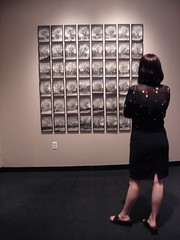
September 9 - October 28, 2007
Jurors : Karen Haas Curator of the Lane Collection at the Museum of Fine Arts, Boston
Arlette Kayafas Director of the Kayafas Gallery, Boston
The show opened last night and we had a lot of fun on a very sultry late summer evening. Met lots of great folks. The show got a write up in the Boston Globe, read the full review
An excerpt:
Ask Karen Haas, curator of the Museum of Fine Arts Lane Collection, about the range of work chosen, and the excitement in her voice is palpable.
"Some of the work that we particularly loved felt very personal," said Haas, who cocurated this year's biennial with Arlette Kayafas, director of Kayafas Gallery of Boston. "For example, Robert Knight basically goes into people's homes with their permission, but without knowing them . . . and photographs their possessions and objects of meaning, and the images he captures are really very telling and really quite beautiful in the way they capture the light."
She goes on to discuss newcomer Josh Winer, who creates "fascinating images out of piles of raw materials with no sense of context, so you have no idea whether you're looking at a pile of sand or a mountain of it."
Then there's Amber Davis Tourlentes's portraits of alternative families, who she photographs while grouped together on a stage.
Or Erik Gould, who "takes the banal and makes it quirky" with a series of photos of, say, parking shacks.



















